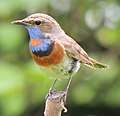| Bluethroat | |
|---|---|
 | |
| Male Luscinia svecica svecica, Oppdal, Norway | |
| Song recorded in Chukotka, Russia | |
| Scientific classification | |
| Kingdom: | Animalia |
| Phylum: | Chordata |
| Class: | Aves |
| Order: | Passeriformes |
| Family: | Muscicapidae |
| Genus: | Luscinia |
| Species: | L. svecica |
| Binomial name | |
| Luscinia svecica | |
 | |
| Distribution of the bluethroat (orange: breeding range; blue: non-breeding range) | |
| Synonyms | |
| |
The bluethroat (Luscinia svecica) is a small passerine bird that was formerly classed as a member of the thrush family Turdidae, but is now known to be an Old World flycatcher. It, and similar small European species, are often called chats.
Contents
It is a migratory insectivorous species breeding in wet birch wood or bushy swamp in Europe and across the Palearctic with a foothold in western Alaska. It nests in tussocks or low in dense bushes. It winters in the Iberian Peninsula, the northern half of Africa, and in southern Asia (among others including the Indian subcontinent).
The bluethroat is similar in size to the European robin at 13–14 cm. It is plain brown above except for the distinctive tail, brown with black outer corners and red basal side patches. It has a strong white supercilium. The males have a striking throat pattern, with a vivid glossy blue throat bordered below with (usually) a narrow black band (but see subspecies, below), and a broad brick-red band below that; additionally there is often a central spot, either red or white, in the middle of the blue throat; see subspecies below for details. Despite the distinctive appearance of the males, recent genetic studies show only limited variation between the forms, and confirm that this is a single species. [2] Moult begins in July after breeding and is completed in 40–45 days, before the birds migrate. [3]
The male has a varied and very imitative song. [4] Its call is a typical chat chack noise.










